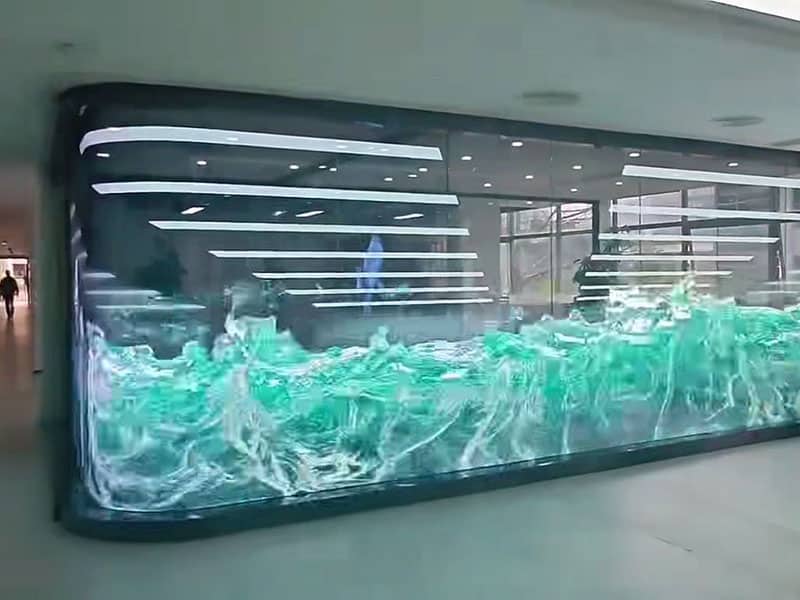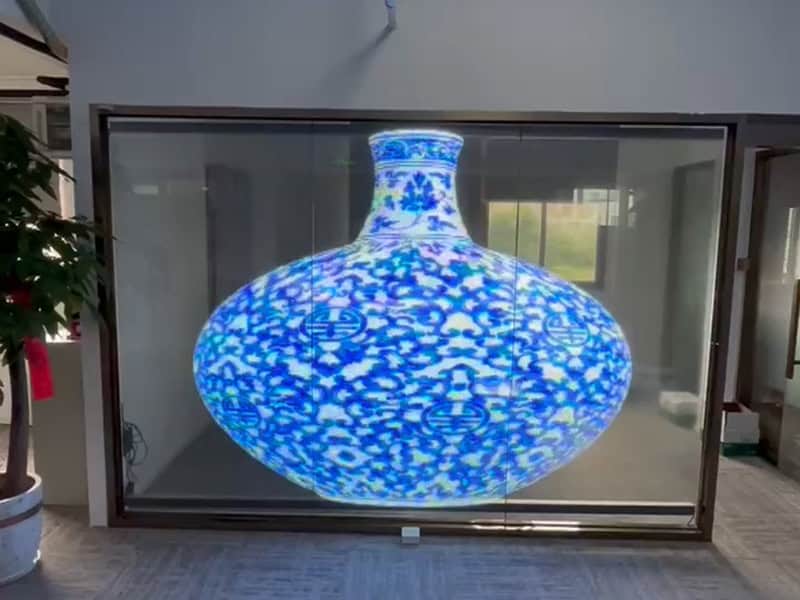Imagine walking by a store and seeing bright, colorful ads right on the window, yet you can still see through to the inside. Or picture a building where even the glass seems to come alive with cool videos or messages, but you can still look out through it. Pretty awesome, right? This kind of futuristic display is made possible by something called transparent LED film, a new technology that’s changing the way we see digital screens.
What Is Transparent Led Film Screen?
Transparent LED film is a cutting-edge display technology that combines traditional LED screen capabilities with high transparency. It’s self-adhesive and easily applies to glass surfaces like windows or railings, offering vibrant displays without obstructing the view or requiring complex installations. Ideal for modern advertising and digital signage.
Now that you know what transparent LED film is, you might be curious about how it works and where you might see it in action. Let’s take a closer look at these aspects to really understand why this technology is so exciting.

How Does A Transparent Led Film Screen Work?
Transparent LED film screens operate through a combination of advanced LED technology and transparent materials, allowing for the display of images and videos while maintaining a high level of transparency. Here’s how they work:
Image Creation: When an electric current passes through the LED chips, they emit light, which combines to create images or videos on the transparent film. The arrangement and spacing of the LEDs are designed to maximize transparency while delivering high-quality visuals.
Transparency Effect: The film allows viewers to see through it when not actively displaying content, providing a dual visual experience. This feature is particularly beneficial in applications like retail displays, where the interior can still be visible.
Dynamic Brightness Adjustment: Many transparent LED films include sensors that adjust the brightness based on ambient light conditions, ensuring optimal visibility in various environments.
Where Can Transparent Led Film Screen Be Used?
Transparent LED film screens can be used in a variety of places thanks to their ability to display bright images while still being see-through. Here are some key areas where they’re commonly used:
Retail Stores: You’ll often find these screens on store windows, showing ads or promotions without blocking the view inside. This helps attract customers while keeping the store’s look open and inviting.
Shopping Malls: Transparent LED films are great for glass walls and partitions, creating cool advertising spots that blend in with the surroundings and don’t block sightlines.
Buildings: They can be applied to the outside of buildings, turning them into huge display screens for ads or announcements, all while letting natural light through.
Public Transport: In buses, trains, or even airplanes, these screens can provide passengers with information or entertainment without covering up the view outside.
Events and Exhibitions: At trade shows or conferences, transparent LED films can showcase products or presentations in a way that’s engaging but doesn’t disrupt the space.
Overall, these screens are super versatile and can be used in many different settings, from retail and transportation to events and architecture.
How To Install Transparent Led Film?
Installing transparent LED film is a straightforward process if you follow the right steps. Here’s a simple guide to help you get started:
Tools and Materials Needed:
Transparent LED Film: Make sure it’s the right size for your glass surface.
Cleaning Supplies: Use glass cleaner and a lint-free cloth to prepare the surface.
Measuring Tools: A tape measure or ruler for precise measurements.
Cutting Tools: Scissors or a utility knife if you need to trim the film.
Squeegee or Flat Tool: To smooth out the film during application.
Electrical Tools: Basic tools might be needed for connecting the film to power.
Step-by-Step Installation Guide:
Surface Preparation: Start by cleaning the glass surface thoroughly. Remove any dust, dirt, or grease to ensure the film sticks well. Use a good glass cleaner and a lint-free cloth for the best results.
Measuring and Cutting: Measure the glass area where you’ll be applying the film. If the film is too large, carefully trim it to the correct size, leaving a little extra on the edges for easier alignment.
Positioning the Film: If your film is self-adhesive, peel off the backing carefully. Align the film with the edges of the glass, making sure it’s straight and centered.
Applying the Film: Starting from one edge, slowly apply the film to the glass. Use a squeegee or flat tool to press the film down and push out any air bubbles. Work from the center towards the edges to ensure a smooth application.
Electrical Connections: Once the film is in place, connect it to the power supply and control system according to the instructions provided. This step may involve connecting wires to a controller that manages the display.
Testing the Display: After everything is set up, power on the display to make sure it’s working properly. Check for any issues, like flickering or dead pixels, and make adjustments if needed.
Tips for a Successful Installation:
Work in a Dust-Free Environment: This helps prevent dust particles from getting trapped under the film.
Get Help: Having an extra pair of hands can make it easier to handle large pieces of film.
Follow the Instructions: Always refer to the manufacturer’s guidelines for the best results.
By following these steps, you can successfully install transparent LED film and create eye-catching displays on glass surfaces.
Main Difference Between Transparent Led Film And Traditional Transparent Led Screen

The main difference between transparent LED film and traditional transparent LED screens comes down to structure, flexibility, and installation.
Structure and Design: Transparent LED film is ultra-thin and flexible, like a sticker, and can be easily applied to glass surfaces, even curved ones. It’s made from lightweight materials and is much simpler in design. On the other hand, traditional transparent LED screens are more rigid and bulky, with a heavier structure that includes multiple components like LED modules and power supplies. These screens are typically installed in a fixed position.
Transparency: Transparent LED film has higher transparency, often above 90%, so it lets more light through and provides a clearer view when the display is off. Traditional transparent LED screens are less transparent, around 50-75%, due to their more complex structure, which can block more of the background.
Flexibility and Installation: Transparent LED film is highly flexible and easy to install—you just stick it onto glass. It can even wrap around curved surfaces. Traditional LED screens are rigid and require more complicated installation with support structures, limiting where you can put them.
In summary, transparent LED film is more flexible, lighter, and easier to install than traditional transparent LED screens, making it a better choice for situations where high transparency and simple installation are important.
Does Transparent Led Film Affect The Clarity Of Glass?

Transparent LED film does not significantly affect the clarity of the glass it’s applied to. It’s designed to maintain high transparency, often between 80% and 95%, which means you can still see through the glass clearly when the display is off. The film is thin and flexible, so it doesn’t block much light or obscure the view. When the LED film is active, it shows bright, colorful images but still allows light to pass through, so the glass looks almost the same as before. Overall, transparent LED film lets you enjoy digital displays without losing the clear view through the glass.
Can I Customize The Transparent Led Film?
Yes, you can customize transparent LED film in several ways to fit your specific needs. Here’s how:
Shapes and Sizes: Transparent LED film can be cut into different shapes and sizes, making it easy to fit onto various surfaces, even if they’re curved or irregular. This means you can design creative and unique displays that perfectly match your space.
Pixel Pitch and Resolution: You can choose the pixel pitch, which is the distance between the LED lights. This affects how clear and detailed the display looks, allowing you to pick the best option based on how far people will be viewing it from.
Brightness Levels: The brightness of the LED film can be adjusted, so it looks great whether you’re using it indoors or outdoors. This ensures your display is visible no matter the lighting conditions.
Design and Content: You can completely customize what you show on the LED film. Whether it’s ads, branding, or other visuals, you have full control over the content to create a unique experience.
Overall, transparent LED film is highly customizable, making it a great choice for businesses looking to create eye-catching displays that fit their specific needs.
Can The Brightness Of Transparent LED Film Be Adjusted Dynamically?
Yes, the brightness of transparent LED film can be adjusted dynamically. This means the film can automatically change its brightness based on the surrounding light conditions. For example, if it’s bright outside, the film will increase its brightness to stay visible. At night, it can lower the brightness to avoid being too harsh or wasting energy.
Some transparent LED films come with sensors that detect the light levels and adjust the brightness automatically. Others allow you to manually control the brightness if you prefer. This feature helps make sure the display looks great no matter the time of day or lighting situation, and it also helps save energy.
Conclusion
In short, transparent LED film is an amazing new technology that turns regular glass into vibrant, eye-catching displays while still letting you see through it. It’s a perfect fit for modern advertising, corporate branding, and public information screens. As this technology becomes more common, it’s likely to change the way we interact with digital content in everyday places.

